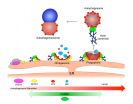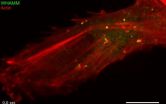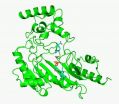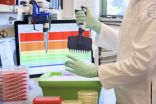Protein 'comet tails' propel cell recycling process
2015-06-18
(Press-News.org) PHILADELPHIA - Several well-known neurodegenerative diseases, such as Lou Gehrig's (ALS), Parkinson's, Alzheimer's, and Huntington's disease, all result in part from a defect in autophagy - one way a cell removes and recycles misfolded proteins and pathogens. In a paper published this week in Current Biology, postdoctoral fellow David Kast, PhD, and professor Roberto Dominguez, PhD, and three other colleagues from the Department of Physiology at the Perelman School of Medicine at the University of Pennsylvania, show for the first time that the formation of ephemeral compartments key in this process require actin polymerization by the Arp2/3 complex, a composite of seven proteins.
They found that the cell recycling machinery is regulated by a protein called WHAMM, and that interfering with this protein or actin polymerization itself severely inhibits the cell's ability to recycle misfolded proteins and damaged organelles via autophagy. This is particularly important for non-dividing neurons, because the accumulation of waste leads to impaired intercellular communication and neurodegeneration.
"Cells are very good at recycling and sorting cellular trash into the correct recycling bins," Dominguez says. "Cells sequester trash in compartments called autophagosomes" Cells follow a set recipe for recycling: First, the autophagosome is formed around the trash, next autophagosomes are transported and merged with lysosomes - another cellular compartment - and finally, the contents are degraded and either secreted or reused by the cell.
The Penn team found that this recycling process is fueled by the actin cytoskeleton, whose major component is the protein actin itself. Autophagosomes arise from the endoplasmic reticulum (ER) -- a network of tubular membranes - and actin dynamics is key in their formation and movement.
The "fuel" for the biogenesis and movement of autophagosomes is provided by actin polymerization powered by the Arp2/3 complex, which is recruited to autophagosomes by WHAMM. Polymerization is the chemical reaction that allows for the formation of molecular chains, in this case, actin filaments.
In cells, proteins that induce the polymerization of actin, such as the Arp2/3 complex, also control it. When the actin polymerization occurs at one spot on the surface of an autophagosome, which coincides with the location of WHAMM on these organelles, an actin comet tail is formed, and the rapid assembly/disassembly of the actin polymers "pushes" the autophagosome toward the lysosome for final processing. The Penn scientists have visualized this phenomenon at high resolution in live cells, revealing the formation of actin "comet tails" that propel the formation and movement of autophagosomes from the ER membrane. The constant assembling and disassembling of actin comet tails on the surface of autophagosomes makes them move with speeds of approximately 0.5 micrometers per second.
"Actin acts like rocket fuel to drive this process" Kast says. "Actin can function as a track for myosin, or as a motor on its own via this comet tail mechanism."
The team starved cells of amino acids to spur the formation of autophagosomes. But why did they home in on WHAMM as the connector in the first place? "Kind of by luck," says Kast. WHAMM was known to exist in the ER and Golgi apparatus, but we really didn't know what role it played. The Dominguez lab was first interested in WHAMM because of its role in the regulation of the Arp2/3 complex, the only branched-actin nucleating system in cells. On the other hand, autophagy was recently shown to involve actin, but the mechanism was unknown. The Penn scientists connected these observations and hypothesized that possibly WHAMM could link actin assembly to autophagy.
They showed that interfering with actin polymerization, knocking down WHAMM, or blocking its interaction with other proteins all inhibit actin "comet tail" formation and reduce the size and number of autophagosomes. These results reveal a link between actin-comet tail motility and autophagy. "Understanding the underlying mechanism for autophagosome formation and maturation will allow us to better understand the differences between the many neurodegenerative diseases that have been linked to defects in autophagy," Kast says.
INFORMATION:
This work was supported by the National Institute of Mental Health and the National Institute of General Medical Sciences (P01 GM087253, R01 MH087950) and the American Cancer Society (PF-13-033-01-DMC).
Co-authors are Allison L. Zajac, Erika L.F. Holzbaur, and E. Michael Ostap, all from Penn.
Penn Medicine is one of the world's leading academic medical centers, dedicated to the related missions of medical education, biomedical research, and excellence in patient care. Penn Medicine consists of the Raymond and Ruth Perelman School of Medicine at the University of Pennsylvania (founded in 1765 as the nation's first medical school) and the University of Pennsylvania Health System, which together form a $4.9 billion enterprise.
The Perelman School of Medicine has been ranked among the top five medical schools in the United States for the past 17 years, according to U.S. News & World Report's survey of research-oriented medical schools. The School is consistently among the nation's top recipients of funding from the National Institutes of Health, with $409 million awarded in the 2014 fiscal year.
The University of Pennsylvania Health System's patient care facilities include: The Hospital of the University of Pennsylvania -- recognized as one of the nation's top "Honor Roll" hospitals by U.S. News & World Report; Penn Presbyterian Medical Center; Chester County Hospital; Penn Wissahickon Hospice; and Pennsylvania Hospital -- the nation's first hospital, founded in 1751. Additional affiliated inpatient care facilities and services throughout the Philadelphia region include Chestnut Hill Hospital and Good Shepherd Penn Partners, a partnership between Good Shepherd Rehabilitation Network and Penn Medicine.
Penn Medicine is committed to improving lives and health through a variety of community-based programs and activities. In fiscal year 2014, Penn Medicine provided $771 million to benefit our community.
[Attachments] See images for this press release:


ELSE PRESS RELEASES FROM THIS DATE:
2015-06-18
University of California San Francisco scientists have identified characteristics of a family of daughter cells, called MPPs, which are the first to arise from stem cells within bone marrow that generate the entire blood system. The researchers said the discovery raises the possibility that, by manipulating the fates of MPPs or parent stem cells, medical researchers could one day help overcome imbalances and deficiencies that can arise in the blood system due to aging or in patients with specific types of leukemia.
Similar imbalances can render patients vulnerable immediately ...
2015-06-18
PORTLAND, Ore. -- Advancing the field of structural biology that underpins how things work in a cell, researchers have identified how proteins change their shape when performing specific functions. The study's fresh insights, published online in the journal Structure, provide a more complete picture of how proteins move, laying a foundation of understanding that will help determine the molecular causes of human disease and the development of more potent drug treatments.
Though it has long been recognized that proteins are not static, for more than 30 years, scientists' ...
2015-06-18
The secret to preventing HIV infection lies within the human immune system, but the more-than-25-year search has so far failed to yield a vaccine capable of training the body to neutralize the ever-changing virus. New research from The Rockefeller University, and collaborating institutions, suggests no single shot will ever do the trick. Instead, the scientists find, a sequence of immunizations might be the most promising route to an HIV vaccine.
Scientists have thought for some time that multiple immunizations, each tailored to specific stages of the immune response, ...
2015-06-18
BOSTON, June 18 -- An analysis of five families has revealed a previously unknown genetic immunodeficiency, says an international team led by researchers from Boston Children's Hospital. The condition, linked to mutations in a gene called DOCK2, deactivates many features of the immune system and leaves affected children open to a unique pattern of aggressive, potentially fatal infections early in life.
As the researchers -- led by Kerry Dobbs and Luigi Notarangelo, M.D., of Boston Children's Division of Allergy and Immunology -- reported today in the New England Journal ...
2015-06-18
Musicians don't just hear in tune, they also see in tune.
That is the conclusion of the latest scientific experiment designed to puzzle out how the brain creates an apparently seamless view of the external world based on the information it receives from the eyes.
"Our brain is remarkably efficient at putting us in touch with objects and events in our visual environment, indeed so good that the process seems automatic and effortless. In fact, the brain is continually operating like a clever detective, using clues to figure out what in the world we are looking at. And ...
2015-06-18
A trio of studies being published today in the journals Science and Cell describes advances toward the development of an HIV vaccine. The three study teams all demonstrated techniques for stimulating animal cells to produce antibodies that either could stop HIV from infecting human cells in the laboratory or had the potential to evolve into such antibodies. Each of the research teams received funding from the National Institute of Allergy and Infectious Diseases (NIAID), part of the National Institutes of Health.
In one study, published in Science, researchers demonstrate ...
2015-06-18
CHAPEL HILL, NC - Before there were cells on Earth, simple, tiny catalysts most likely evolved the ability to speed up and synchronize the chemical reactions necessary for life to rise from the primordial soup. But what those catalysts were, how they appeared at the same time, and how they evolved into the two modern superfamilies of enzymes that translate our genetic code have not been understood.
In the Journal of Biological Chemistry, scientists from the UNC School of Medicine provide the first direct experimental evidence for how primordial proteins developed the ...
2015-06-18
Parkinson disease (PD) appeared associated with 16 types of cancer in a study in Taiwan, an effort to explain the association in an East Asian population because most prior research has been conducted in Western populations, according to an article published online by JAMA Oncology.
During the past 50 years, more than 25 epidemiological studies have been conducted on the association between PD and cancer, and most of those studies showed that individuals with PD had a decreased risk of cancer compared to those without PD. However, most of those studies were done in Western ...
2015-06-18
A survey carried out earlier this year has found the first evidence of the 'superbug' bacteria Methicillin-Resistant Staphylococcus aureus (MRSA) in sausages and minced pork obtained from supermarkets in the UK. However, researchers stress that this does not pose a significant immediate risk to the public.
In February, a team of researchers funded primarily by the Medical Research Council (MRC) bought and analysed a total of 103 (52 pork and 51 chicken) pre-packaged fresh meat products, labelled as being of UK farm origin, from supermarkets in five different locations ...
2015-06-18
PITTSBURGH, June 17 -- Regardless of chronological age, people who live in neighborhoods with high crime, noise and vandalism are biologically more than a decade older than those who do not, according to a study led by researchers from the University of Pittsburgh. The findings were published online today in PLOS One.
Strong research evidence supports that living in disadvantaged neighborhoods has an unfavorable impact on mental and physical health, explained lead author Mijung Park, Ph.D., M.P.H., R.N., assistant professor, University of Pittsburgh School of Nursing. ...
LAST 30 PRESS RELEASES:
[Press-News.org] Protein 'comet tails' propel cell recycling process





